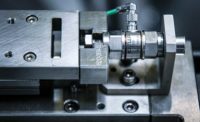Visitors to assembly plants are often overwhelmed by the size of a facility, or the quickness of a process, or the large number of the same type of machine in one or more areas. At Automation Plastics Corp.’s (APC) assembly plant in Aurora, OH, guests are always impressed when they see the many rows of horizontal injection presses that fill the 50,000-square-foot facility.
Workers there operate a total of 33 presses to complete a wide range of injection-molding, part-design, prototyping, machining and assembly projects. Although small, APC has a large customer base that includes Fortune 500 companies in the medical, aerospace, construction and consumer products industries.
The company opened in 1979 and, until recently, it created assembly work instructions using Word, Powerpoint, Crystal Reports and PDF files. Relying on several file formats, however, prevented APC’s training and quality managers from creating a system that allowed standardization and was easy to update. Most importantly, this approach prevented the facility from achieving ISO certification compliance.
“It was a mess, [with] no structured system for work guidance and documentation,” explains Ipper Collens, training and process improvement specialist at APC. “It wasn’t unusual to see three or four versions of the same document in use on the shop floor. This poor communication was a major problem that derailed everyone’s performance.”
Last year, the company decided to switch to software-based work instructions, with Collens and quality technician Anne Klonowski leading the research effort. The duo wanted an easy-to-use software platform that has built-in version control, supports video integration and streamlines the approval process. They found all of these capabilities in Dozuki cloud-based software.
Collens says that the software provides APC operators with more documentation features and control than ever before. For example, they can instantly access the latest process updates via tablets and mobile devices at their workstations.
She also likes that the software makes it easy for veteran operators to document their extensive knowledge and provide it to their colleagues. When this information was not easily accessible, it took about four hours to train a new operator. Now it takes only 15 minutes.
The software’s version control feature lets end-users quickly update documents. Once a new version has been released, all users instantly gain access to it, and outdated versions become restricted. By using the centralized management feature, a person can create, modify and distribute documents from a single location, then route them for approvals (using electronic signatures) and publish them to prevent production bottlenecks.
Data capture occurs in real time and is possible from one or more documents. In addition, data may be securely accessed by employees on- or off-site. Dozuki backs up this data four times each day and keeps backup copies of documents dating back up to two years.
“Our previous processes were created and tracked in paper binders and took more than 24 hours to get approved,” concludes Collens. “Now it just takes one hour. Necessary stakeholders receive an instant alert, and review and approve it. Then it gets sent to the shop floor immediately.”
For more information on cloud-based documentation software, call 866-613-4948 or visit www.dozuki.com.




